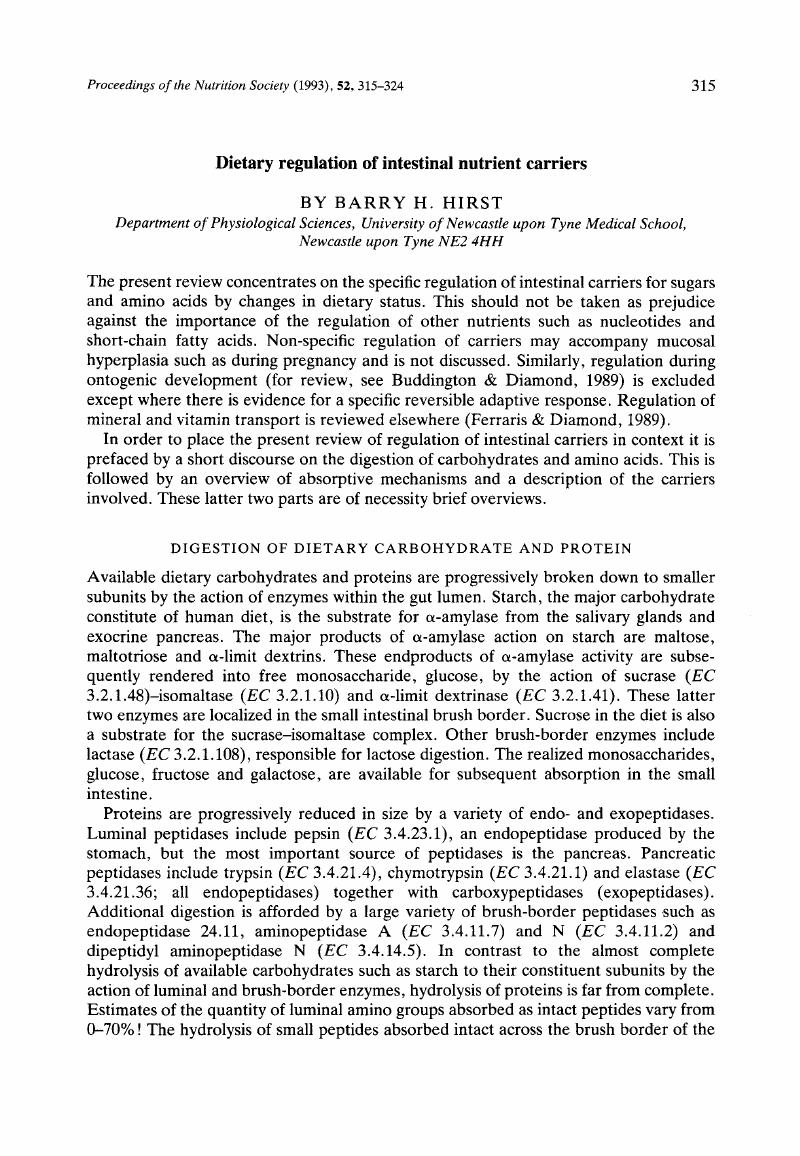Crossref Citations
This article has been cited by the following publications. This list is generated based on data provided by Crossref.
Jourdheuil-Rahmani, Dominique
Rolland, Pierre H.
Masset, Dominique
Garcon, Danielle
and
Rahmani, Roger
1995.
Alterations of Methionine Fluxes and Incorporation in Intestines of Miniature Pigs Fed a Diet High in Caseinate Are Restricted by Angiotensin-Converting Enzyme Inhibitor.
The Journal of Nutrition,
Vol. 125,
Issue. 12,
p.
3011.
Bates, C J
1997.
Vitamin Analysis.
Annals of Clinical Biochemistry: International Journal of Laboratory Medicine,
Vol. 34,
Issue. 6,
p.
599.
Schroeder, Bernd
Dahl, Maria Regina
and
Breves, Gerhard
1998.
Duodenal Ca2+absorption is not stimulated by calcitriol during early postnatal development of pigs.
American Journal of Physiology-Gastrointestinal and Liver Physiology,
Vol. 275,
Issue. 2,
p.
G305.
Gomes-Marcondes, M.C.C.
Honma, H.N.
Areas, M.A.
and
Cury, L.
1998.
Effect of Walker 256 tumor growth on intestinal absorption of leucine, methionine and glucose in newly weaned and mature rats.
Brazilian Journal of Medical and Biological Research,
Vol. 31,
Issue. 10,
p.
1345.
Schröder, Bernd
Hattenhauer, Olaf
and
Breves, Gerhard
1998.
Phosphate Transport in Pig Proximal Small Intestines during Postnatal Development: Lack of Modulation by Calcitriol*.
Endocrinology,
Vol. 139,
Issue. 4,
p.
1500.
Hughes, R. E.
2000.
The Cambridge World History of Food.
p.
1685.
2000.
The Cambridge World History of Food.
p.
1575.
Carter, Chris
Houlihan, Dominic
Kiessling, Anders
Médale, Francoise
and
Jobling, Malcolm
2001.
Food Intake in Fish.
p.
297.
Ventrucci, Gislaine
de Mello, Maria Alice Roston
and
Gomes-Marcondes, Maria Cristina Cintra
2002.
Effects of leucine supplemented diet on intestinal absorption in tumor bearing pregnant rats.
BMC Cancer,
Vol. 2,
Issue. 1,
Schröder, B.
Huber, K.
and
Breves, G.
2002.
Biology of the Intestine in Growing Animals.
Vol. 1,
Issue. ,
p.
605.
Ventrucci, Gislaine
Ramos Silva, Luis Gustavo
Roston Mello, Maria Alice
and
Gomes Marcondes, Maria Cristina Cintra
2004.
Effects of a leucine-rich diet on body composition during nutritional recovery in rats.
Nutrition,
Vol. 20,
Issue. 2,
p.
213.
Berge, Gerd Eikeland
Goodman, Mark
Espe, Marit
and
Lied, Einar
2004.
Intestinal absorption of amino acids in fish: kinetics and interaction of the in vitro uptake of l-methionine in Atlantic salmon (Salmo salar L.).
Aquaculture,
Vol. 229,
Issue. 1-4,
p.
265.
Præbel, Kim
and
Ramløv, Hans
2005.
Antifreeze activity in the gastrointestinal fluids ofArctogadus glacialis(Peters 1874) is dependent on food type.
Journal of Experimental Biology,
Vol. 208,
Issue. 13,
p.
2609.
Saavedra, M.
Conceição, L.E.C.
Helland, S.
Pousão-Ferreira, P.
and
Dinis, M.T.
2008.
Effect of lysine and tyrosine supplementation in the amino acid metabolism of Diplodus sargus larvae fed rotifers.
Aquaculture,
Vol. 284,
Issue. 1-4,
p.
180.
Pinto, Wilson
Rodrigues, Vera
Dinis, Maria Teresa
and
Aragão, Cláudia
2010.
Can dietary aromatic amino acid supplementation be beneficial during fish metamorphosis?.
Aquaculture,
Vol. 310,
Issue. 1-2,
p.
200.
Bender, David A.
2011.
Vitamin B6: Beyond Adequacy.
Journal of Evidence-Based Complementary & Alternative Medicine,
Vol. 16,
Issue. 1,
p.
29.
Raubenheimer, David
Simpson, Steve
Sánchez‐Vázquez, Javier
Huntingford, Felicity
Kadri, Sunil
and
Jobling, Malcolm
2012.
Aquaculture and Behavior.
p.
150.
Poncet, Nadège
and
Taylor, Peter M.
2013.
The role of amino acid transporters in nutrition.
Current Opinion in Clinical Nutrition and Metabolic Care,
Vol. 16,
Issue. 1,
p.
57.
Chen, Ming-xia
Li, Xiang-guang
Yang, Jun-xian
Gao, Chun-qi
Wang, Bin
Wang, Xiu-qi
and
Yan, Hui-chao
2015.
Growth of embryo and gene expression of nutrient transporters in the small intestine of the domestic pigeon (Columba livia).
Journal of Zhejiang University-SCIENCE B,
Vol. 16,
Issue. 6,
p.
511.
Moran, Edwin T.
2016.
Gastric digestion of protein through pancreozyme action optimizes intestinal forms for absorption, mucin formation and villus integrity.
Animal Feed Science and Technology,
Vol. 221,
Issue. ,
p.
284.



